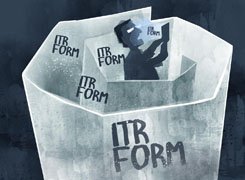Ramalingam Kalirajan |8319 Answers |Ask -Follow
Mutual Funds, Financial Planning Expert - Answered on May 18, 2024
He has an MBA in finance from the University of Madras and is a certified financial planner.
He is the director and chief financial planner at Holistic Investment, a Chennai-based firm that offers financial planning and wealth management advice.... more

Sir I'm 52yr old house wife.my husband 60 now... We need to invest 35lack from which I must get good intrest I mean returns,so I can educate my 13yrs old child with its intrest money
Understanding Your Investment Goals
Given your age and your husband's age, it's essential to focus on investments that offer a balance between safety, income generation, and moderate growth. Your primary goal is to generate sufficient returns to cover your child's education expenses. Therefore, a mix of debt and equity investments may be suitable.
Fixed Deposits and Debt Funds
Fixed Deposits (FDs):
Safety: FDs are one of the safest investment options. Banks and post offices offer fixed deposits with guaranteed returns.
Interest Rates: While FD interest rates are relatively lower than equity investments, they provide assured returns. You can ladder your FDs to take advantage of varying interest rates and maintain liquidity.
Debt Mutual Funds:
Types: Consider short-term debt funds, corporate bond funds, or dynamic bond funds.
Returns: Debt funds generally offer higher returns than fixed deposits but come with some level of risk. They invest in government securities, corporate bonds, and money market instruments.
Liquidity: These funds are more liquid than FDs, allowing you to withdraw money if needed.
Balanced Advantage Funds
Balanced Advantage Funds:
Mix of Equity and Debt: These funds dynamically allocate assets between equity and debt based on market conditions. This provides a balance of growth potential and risk management.
Moderate Risk: Suitable for conservative investors looking for better returns than pure debt investments with manageable risk.
Income Generation: These funds can provide regular income through Systematic Withdrawal Plans (SWP).
Dividend-Paying Stocks and Equity Mutual Funds
Dividend-Paying Stocks:
Regular Income: Investing in high-quality, dividend-paying stocks can provide regular income. Choose companies with a consistent track record of paying dividends.
Growth Potential: Along with dividends, there is potential for capital appreciation.
Equity Mutual Funds:
Diversification: Investing in large-cap or multi-cap equity mutual funds provides diversification across various sectors and companies.
Growth and Income: While equity funds are subject to market risks, they offer the potential for higher returns over the long term. You can set up an SWP to receive regular income.
Systematic Withdrawal Plan (SWP)
Systematic Withdrawal Plan (SWP):
Regular Income: SWPs allow you to withdraw a fixed amount from your mutual fund investments regularly. This can provide a steady income stream to cover education expenses.
Tax Efficiency: SWPs are more tax-efficient compared to regular fixed deposits, as only the gains are taxed, not the principal.
Recommended Strategy
Given your objectives, a diversified approach combining safety and moderate growth is advisable:
Fixed Deposits (30% - 35%): Allocate a portion to FDs for guaranteed returns and safety.
Debt Mutual Funds (30%): Invest in high-quality debt mutual funds for better returns than FDs with manageable risk.
Balanced Advantage Funds (20% - 25%): These funds provide a good balance of growth and income.
Equity Mutual Funds (15% - 20%): Allocate to large-cap or multi-cap equity funds for growth potential.
Regular Monitoring
Regularly review your investments to ensure they align with your financial goals. Adjust the portfolio based on changes in interest rates, market conditions, and your child's education expenses.
Conclusion
With a thoughtful mix of fixed deposits, debt funds, balanced advantage funds, and equity mutual funds, you can create a stable and growing investment portfolio. This approach aims to generate the income needed for your child's education while preserving and potentially increasing your capital.
Best Regards,
K. Ramalingam, MBA, CFP,
Chief Financial Planner,
www.holisticinvestment.in
You may like to see similar questions and answers below
Ramalingam Kalirajan |8319 Answers |Ask -Follow
Mutual Funds, Financial Planning Expert - Answered on Jan 06, 2024
Ramalingam Kalirajan |8319 Answers |Ask -Follow
Mutual Funds, Financial Planning Expert - Answered on Apr 05, 2024
Ramalingam Kalirajan |8319 Answers |Ask -Follow
Mutual Funds, Financial Planning Expert - Answered on Aug 03, 2024
Ramalingam Kalirajan |8319 Answers |Ask -Follow
Mutual Funds, Financial Planning Expert - Answered on Aug 13, 2024
Prof Suvasish Mukhopadhyay |612 Answers |Ask -Follow
Career Counsellor - Answered on May 05, 2025
Prof Suvasish Mukhopadhyay |612 Answers |Ask -Follow
Career Counsellor - Answered on May 05, 2025
Mihir Tanna |1052 Answers |Ask -Follow
Tax Expert - Answered on May 05, 2025
Samraat Jadhav |2269 Answers |Ask -Follow
Stock Market Expert - Answered on May 05, 2025
Samraat Jadhav |2269 Answers |Ask -Follow
Stock Market Expert - Answered on May 05, 2025
Samraat Jadhav |2269 Answers |Ask -Follow
Stock Market Expert - Answered on May 05, 2025
Ramalingam Kalirajan |8319 Answers |Ask -Follow
Mutual Funds, Financial Planning Expert - Answered on May 05, 2025
Prof Suvasish Mukhopadhyay |612 Answers |Ask -Follow
Career Counsellor - Answered on May 05, 2025
Prof Suvasish Mukhopadhyay |612 Answers |Ask -Follow
Career Counsellor - Answered on May 05, 2025
Radheshyam Zanwar |1595 Answers |Ask -Follow
MHT-CET, IIT-JEE, NEET-UG Expert - Answered on May 05, 2025

























